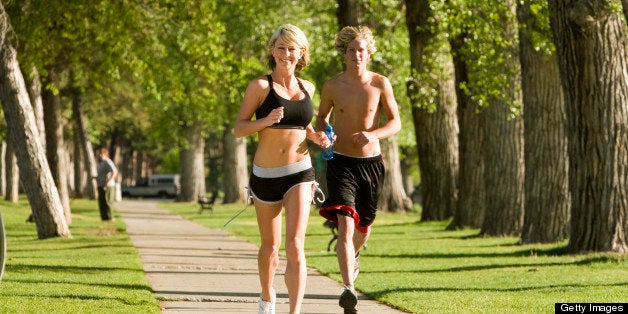
"I thought I was going to die during my workout!" These are words I frequently hear after a client believes she has given it her all in the gym, but has she really? How do you know if you have given 125 percent to your workout?
1) Rate of Perceived Exertion. I often use the rate of perceived exertion to measure a client's intensity during a workout. The American Council on Exercise defines the rate of perceived exertion (RPE scale) "by use of a 0-to-10 chart to rate the feelings caused by your exertion." For example, sitting in front of the TV gets a rating of 0. The rating of exertion should be independent of pace and depend on feelings caused by exertion. Increasing pace or adding a hill could have you working more toward a 10 on the scale. I tell my clients to work at a higher rate of perceived exertion because most people think they are working out at an 8 when they are only at a 5.
2) Actual Heart Rate. Another method of measurement is a heart rate monitor. It tells you what your exact HR is at any given moment, and how many calories you have burned during a workout. It can also determine if you are working out within your target heart rate zone. If you know your maximum heart rate, you can ensure you are working at the appropriate intensity.
To figure out your maximum heart rate (HRmax):
1.The age-based calculation. Use this formula: 220 (men) or 226 (women) minus age. For example, a 26-year-old woman's maximum heart rate would be 226 - 26 = 200. The age-based calculation provides an average statistical prediction of your HRmax and is better for beginners.
2.Record your highest heart rate. You can do this by working out at maximum effort. HRmax depends on the activity, so Polar suggests you establish HRmax with the sports you do most often. Polar has an online test to determine HRmax for running.
3.Clinical stress testing. Recommended for accuracy and specifically for people over the age of 40, overweight, sedentary or have a family history of heart disease. A cardiologist or exercise physiologist will determine your HRmax with a treadmill.
Once you know your HRmax, you can determine how hard you are truly working, using percentages. Are you working at 60 percent of your HRmax, or maximum possible effort? Determine the heart zone you should be working within for your individual goals using the categories here.
3) Quality over Quantity. If you are going to the gym six days a week and working out for more than two hours each time, you are not maximizing your workouts. The intensity of activity should dictate the amount of time you spend. If you were doing 20 minutes of hill sprints, it would not be sustainable like 40 minutes of slow, steady cardio would be. While variety is key, the goal is to workout harder in a shorter amount of time. Exercises engaging fast-twitch muscle fibers (plyometric drills, sprints and High-Intensity Interval Training (or HIIT)) burn more calories during your workout and maximize calories burned afterward (known as the after-burn effect.) The same holds true for compound strength training movements activating more than one muscle at once. If you have an hour or more, hit the weights and then do cardio. Cardio burns carbohydrates first and then fat, so utilize energy from carbohydrates in your body to fuel your strength session, and then move on to cardio where your body will have no choice but to burn fat. If you only have 30 minutes, hit the weights instead of cardio. You will burn more fat because strength training increases your metabolism. Cardio expends more calories during the workout, but may not have as much after-burn.
4) Muscle Fatigue. Pushing your body to muscular fatigue may result in a "jello" effect, accelerated rate of muscle burn or your muscles "giving out" during a rep. Your muscles reach maximum effort once they can no longer contract, or "working to failure." Doing this during a sprint or weight lifting set is the point of maximum effort. It is possible to also push too hard, which can leave you feeling dizzy, weak, or nauseous. If this happens, sit and sip water. If that doesn't help, call it a day and get proper nutrition into your body. Another risk of overexertion is injury, especially without a proper warm-up. Movements resulting in a popping, snapping, cracking sound, or a feeling of pulling and engaging muscles that you are not focusing on are signs of a serious injury or muscle strain. Stop immediately and consult your physician.
5) Increased Hunger. Increase in hunger immediately after or during your workout, general growing appetite or cravings for carbohydrates are normal with heightened energy expenditure. Your body needs fuel to perform and utilizes carbohydrates for energy throughout the day and during exercise. Eat your carbs and required calories, especially within the first 30 minutes after working out.
Make the most of your time. A quality, intense workout always exceeds a long, mediocre workout. On the flip side, remember that too much of a good thing is still too much. Happy training!
For more by Keri Lynn Ford, click here.
For more on fitness and exercise, click here.